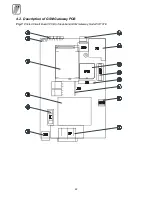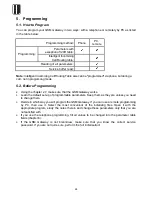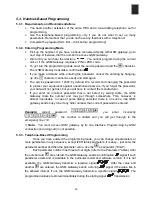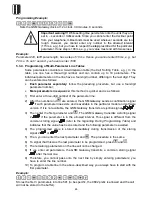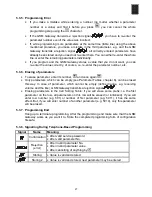
13
3.1.6. Call
During outgoing calls, the GSM Gateway is computing the cost (pseudo tariff metering)
and it can send tariff pulses. A call may be terminated forcibly if the GSM signal gets lost,
for example, or in similar situations.
3.1.7. Connection Termination (End)
If the caller is the first to hang up, the GSM Gateway registers the on-hook immediately
(the current flow stops) and terminates the connection. If the called party is the first to
hang up, the GSM Gateway gets the information from the GSM network and terminates
the connection. The GSM Gateway can pass the information to the PBX. The calling
party gets the busy tone
(or another type depending on the set-up).
The time of call may be limited by parameter 158. 30 sec before this limit, GSM gateway
sends a warning tone. Last 10 sec a short beep repeats each second. A call interruption
follows, optionally busy tone and Power Down.
Note:
With some calls, the called party‘s on-hook information is considerably delayed by
GSM network (30s, e.g.). The subscriber usually registers the on-hook earlier, hangs up,
and the GSM Gateway terminates the connection immediately.
3.1.8. Subscriber’s Disconnection (Power Down)
If a subscriber blocks the GSM Gateway by seizing the line without dialling a number, or
fails to hang up after the call, he or she will get the busy tone
first and
then is disconnected (Power Down status).
3.2. Incoming Call
3.2.1. GSM Gateway Ringing, Extension Dialling, Extension Ringing and Connection
Establishing
When the GSM Gateway receives a command from the GSM network and, if available,
the CLIP information, it starts ringing (i.e. generating the ringing voltage – whose timing is
programmable) into the PBX. The PBX registers the ringing and then, one of the
following situations may occur:
3.2.1.1 PBX without DISA = Selected Extension Ringing
In this case, the selected extension (or several extensions at the same time or
sequentially according to the PBX set-up) starts ringing and the calling subscriber will
not pay for the call until the ringing extension answers.
3.2.1.2 PBX with DISA, Intelligent Routing Off
In this case, the PBX answers and starts reproducing the so-called DISA message.
The GSM Gateway establishes connection immediately in order that the caller can
hear the message and dial the required extension.
3.2.1.3 PBX with DISA, Intelligent Routing On, and CLIP Present and Known
In this case, the PBX also answers and starts reproducing the DISA message. The
GSM Gateway, however, has found the caller’s number in its Intelligent Incoming Call
Routing Table and thus knows the extension to be called. Therefore, the GSM Gateway
does not establish connection immediately, but serves the DISA function (waits and dials
the extension number). Then, it establishes the connection and the calling subscriber can
hear the ringing tone
and the called subscriber.
Summary of Contents for ATEUS 501101E
Page 2: ......
Page 35: ...33 5 4 11 Remote Supervision Establishing Flow Chart ...
Page 56: ......
Page 57: ... 2002 2N TELEKOMUNIKACE a s Prague DR 972 v 1 33 ...
























